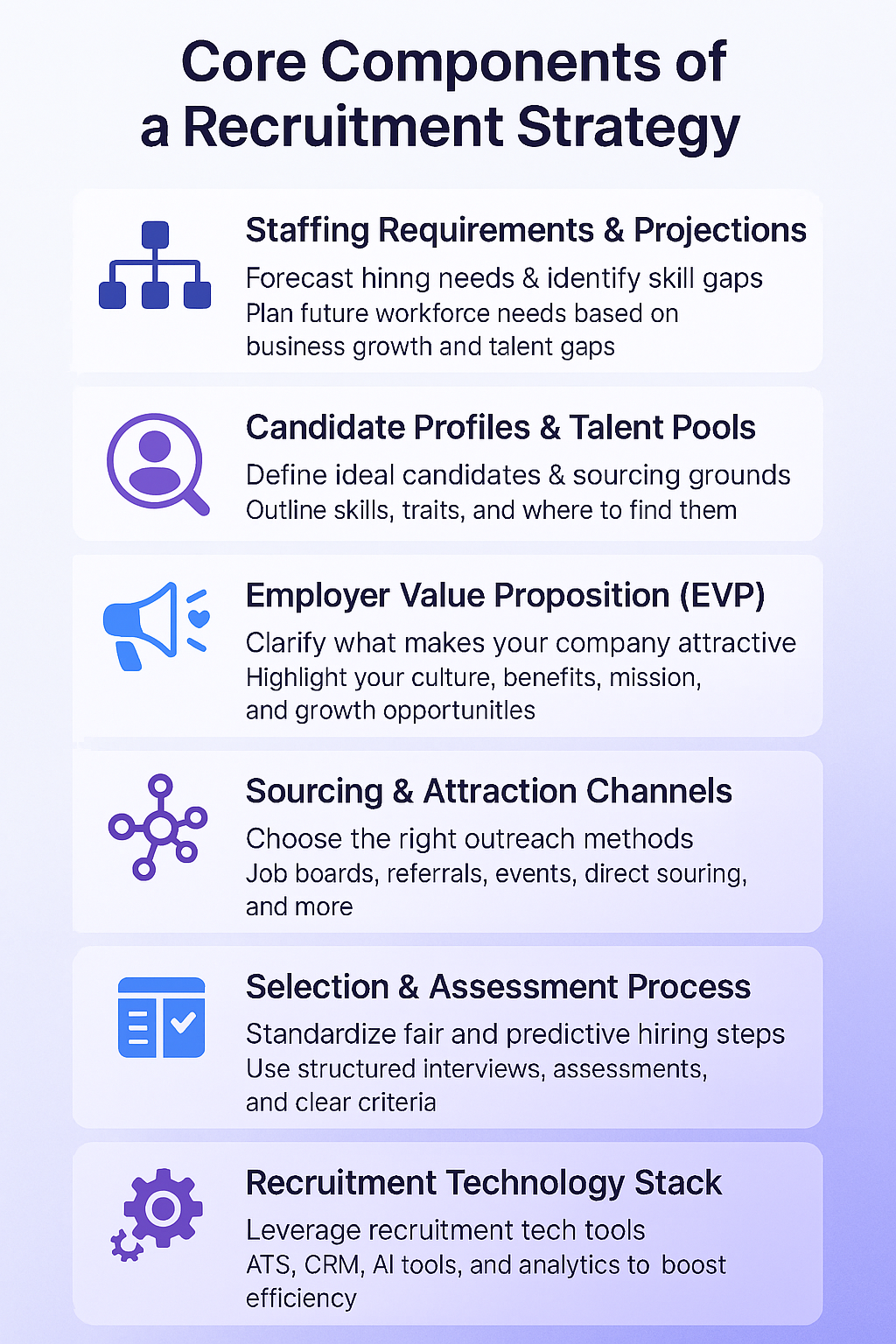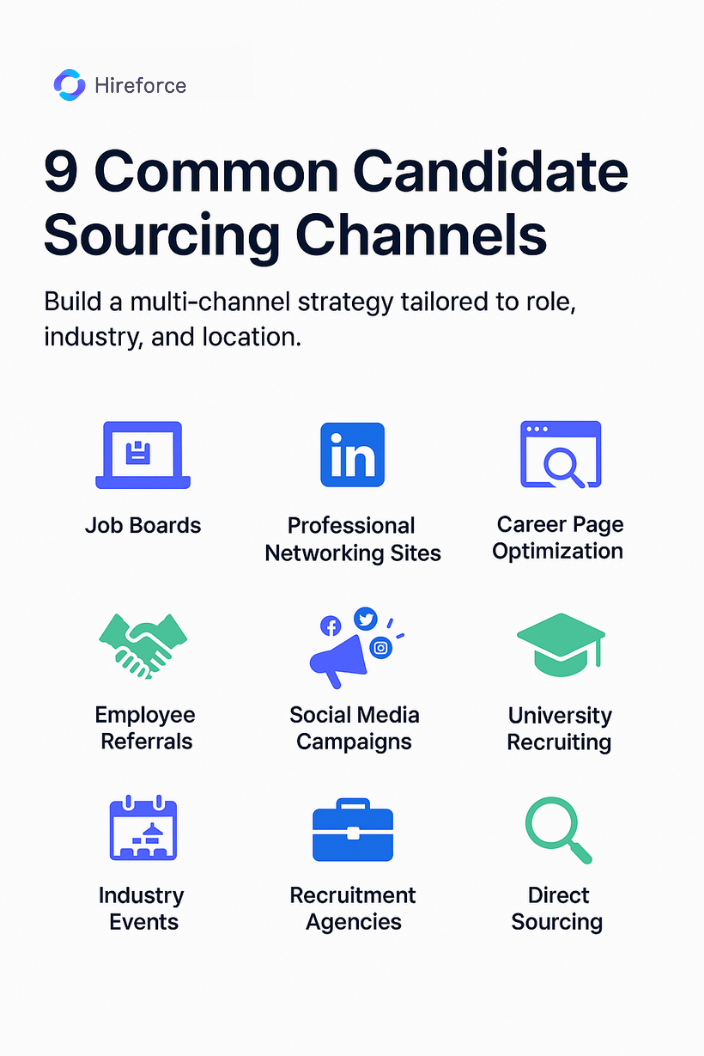Simply posting jobs and hoping for the best is a recipe for inefficiency and missed opportunities. In the complex and competitive landscape of modern business, attracting, hiring, and retaining the right talent is a critical driver of organizational success. A robust Recruitment Strategy provides the necessary framework to navigate this landscape effectively. It's a comprehensive, strategic plan that guides how your organization sources, attracts, evaluates, interviews, hires, and onboards talent, ensuring it aligns with overarching business goals and values.
1. What is a Recruitment Strategy?
At its core, a Recruitment Strategy is a formal, long-term, goal-oriented approach designed to systematically identify, attract, screen, interview, select, and onboard the best possible candidates to meet organizational needs. It moves beyond filling immediate vacancies to consider future workforce requirements, ensuring the right talent with the right skills is available when needed.
Considers factors like projected company growth, required skill sets (both current and future), budget constraints, market conditions, desired company culture, and diversity and inclusion goals. It also formalizes how the organization presents itself to potential hires through its Employer Value Proposition (EVP) and shapes the overall candidate experience. A well-defined strategy ensures consistency, efficiency, and effectiveness across the hiring process.
Core Components of a Recruitment Strategy
Effective recruitment stems from deliberate planning; by carefully outlining the key steps and components, you can move beyond reactive hiring and build proactive strategies tailored to your business needs. Understanding these core elements is the first step towards achieving more efficient and successful hiring outcomes. Here are the essential components that form the foundation of a comprehensive recruitment strategy:
- Staffing Requirements, Projections: Understanding current headcount, forecasting future needs based on business plans (e.g., expansion, new products), identifying potential skill gaps, and planning workforce composition.
- Candidate Profiles & Available Talent Pools: Defining the ideal candidate personas for key roles (including skills, experience, and cultural attributes) and identifying where this talent can be found (internal pools, external channels, specific industries, geographic locations). This involves understanding the available talent pipeline and potential sourcing grounds.
- Budget & Resource: Allocating financial resources effectively across different recruitment activities (e.g., technology, advertising, agency fees, referral bonuses) and optimizing the deployment of the recruitment team's time and effort.
- Employer Value Proposition (EVP) Clarity: Defining and consistently communicating what makes the organization a unique and attractive place to work – including culture, compensation, benefits, career development opportunities, and mission.
- Sourcing & Attraction Channels: Determining the most effective methods for reaching target candidates (e.g., job boards, social media, referrals, events, direct sourcing).
- Selection & Assessment Process: Standardizing interview procedures, assessment tools (including potentially skills-based hiring methods), and evaluation criteria to ensure fairness, consistency, and predictive validity.
- Technology Stack: Defining the role of tools like an Applicant Tracking System (ATS), CRM, AI recruitment software, and analytics platforms.
- Metrics & KPIs: Establishing clear hiring KPIs to measure success and identify areas for improvement (e.g., time-to-hire, quality of hire, cost-per-hire).

2. Why is a Recruitment Strategy Important?
Implementing a suitable recruitment strategy offers profound benefits beyond simply filling jobs faster. It's a strategic imperative with far-reaching positive impacts:
Attracting Top Talent
A proactive strategy allows you to actively seek out the best candidates, including highly valuable passive candidates who aren't actively job searching but might be open to the right opportunity. Planned candidate sourcing and strong employer branding efforts attract higher-caliber individuals than reactive posting alone.
Improving Hiring Quality
By defining precise role requirements, focusing on essential skills (through skills-based hiring approaches), and implementing structured assessment processes, a strategy helps ensure hires possess the necessary competencies and align well with the company culture, leading to better performance and fit.
Enhancing Employee Retention
Hiring individuals whose values and career aspirations align with the organization from the outset significantly improves retention rates. A strategic approach considers long-term fit, not just immediate qualifications, reducing costly turnover.
Optimizing Resources
A clear strategy prevents wasted effort and resources. It guides budget allocation towards the most effective channels, streamlines the hiring process using technology like an ATS, and ensures the recruitment team focuses on high-impact activities, improving overall efficiency.
Supporting Business Goals
Recruitment becomes a strategic partner to the business. Hiring efforts are directly aligned with company objectives, such as supporting expansion into new markets, acquiring talent with specific skills needed for innovation, or building teams to launch new products.
Building Employer Brand
Every touchpoint in a strategic recruitment process contributes to the employer branding. A positive, transparent, and efficient candidate experience enhances the company's reputation, attracting more high-quality applicants and making candidates more likely to accept offers, even if not hired initially.
Ensuring Compliance and Diversity
A formal strategy provides the framework for implementing fair, consistent, and legally compliant hiring practices. It's essential for effectively executing diversity hiring initiatives and achieving Diversity, Equity, and Inclusion (DEI) objectives by embedding inclusive practices throughout the process.

3. How to Create and Implement a Recruitment Strategy (Step-by-Step)
Developing and rolling out an effective recruitment strategy requires careful planning and execution. Follow these key steps:
Step 1: Assess Organizational Needs & Goals: Begin by understanding where the business is headed. Analyze strategic plans, growth projections, and potential market shifts. Conduct workforce planning to identify current and future staffing needs, critical roles, and potential skill gaps. Engage with leadership and department heads to understand their specific talent requirements.
Step 2: Define Clear Roles & Requirements: Move beyond generic job descriptions. For key roles, clearly define responsibilities, required skills (technical and soft), competencies, experience levels, and cultural attributes needed for success. Use inclusive language to attract diverse candidates. This clarity informs sourcing and assessment.
Step 3: Develop Your Candidate Sourcing Plan: Determine the most effective channels to reach your target candidates based on role type, industry, and location. Create a multi-channel candidate sourcing approach that may include:
- Online job boards (general and niche)
- Professional networking sites (like LinkedIn)
- Company career page optimization
- Employee referral programs
- Social media recruiting campaigns
- University relations and campus recruiting
- Industry events and conferences
- Partnerships with recruitment agencies (for specific needs)
- Direct sourcing efforts for passive candidates.

Step 4: Craft & Communicate Your Employer Value Proposition (EVP): What makes your organization a compelling place to work? Define your unique EVP, encompassing factors like company culture, career growth opportunities, compensation and benefits, work-life balance, innovation, and social impact. Ensure this message is communicated consistently across all recruitment materials and touchpoints.
Step 5: Design the Selection & Interviewing Process: Standardize your process to ensure fairness and effectiveness. Define stages (e.g., application review, phone screen, technical assessment, interviews, final selection). Implement structured interviews using behavioral or situational questions focused on required competencies. Consider incorporating objective assessments (cognitive, personality, or skills-based hiring tests) where appropriate, ensuring they are validated and bias-free. Establish clear evaluation criteria and feedback mechanisms.
Step 6: Leverage Recruitment Technology: Implement or optimize tools to streamline the process. An Applicant Tracking System (ATS) is essential for managing applications and candidate data. Consider AI recruitment tools for tasks like resume screening or initial chatbot interactions. Candidate Relationship Management (CRM) or Talent Intelligence platforms (like Talentsforce) are crucial for managing proactive sourcing, building your talent pipeline, automating communication, and analyzing data.
Step 7: Establish Metrics & KPIs: You can't manage what you don't measure. Define key recruitment metrics and hiringprecise KPIs to track performance and identify areas for improvement. Common metrics include:
- Time-to-Fill / Time-to-Hire
- Cost-per-Hire
- Quality of Hire (often measured via new hire performance, retention, or hiring manager satisfaction)
- Source Effectiveness (which channels yield the best hires?)
- Offer Acceptance Rate
- Candidate Experience scores (e.g., via surveys)
- Diversity metrics throughout the funnel.
Step 8: Prioritize Candidate Experience: Every interaction matters. Ensure a smooth, user-friendly application process. Communicate clearly and promptly at each stage, even when delivering rejections. Provide constructive feedback when possible. Treat every candidate with respect – they could be future hires, customers, or brand ambassadors.
Step 9: Plan Effective Onboarding: The recruitment strategy doesn't end with an accepted offer. A structured onboarding process is crucial for integrating new hires effectively, ensuring they become productive quickly, and improving long-term retention. Align onboarding with the promises made during the hiring process.
Step 10: Allocate Budget Strategically: Based on your sourcing plan, technology needs, and overall goals, develop a detailed recruitment budget. Track spending against the budget and analyze the ROI of different activities to optimize resource allocation over time.
4. When is a Recruitment Strategy Needed?

While a thoughtful recruitment strategy benefits organizations of any size, its role shifts from beneficial to absolutely critical under specific pressures or conditions. Facing situations without a clear plan can negatively impact progress. Here are the key moments to review your recruitment strategy:
Continuous Talent Management
Organizations committed to proactively managing talent need an ongoing strategy. This supports continuous talent pipeline building, nurturing potential future hires, and ensuring readiness for unexpected vacancies or growth opportunities.
During Company Growth Phases
Rapid expansion demands a scalable recruitment strategy. Whether entering new markets, launching products, or significantly increasing headcount, a plan is needed to source, assess, and onboard talent efficiently without sacrificing quality.
High Employee Turnover Situations
If turnover rates are high, a reactive approach will only perpetuate the cycle. A strategy is needed to diagnose root causes (often related to poor hiring fit or culture issues), improve candidate selection for better alignment, and potentially focus on roles crucial for retention.
Critical Skills Gaps Identified
When specific, hard-to-find expertise is needed (e.g., AI specialists, niche engineers, regulatory experts), a targeted recruitment strategy focusing on specialized candidate sourcing techniques and potentially skills-based hiring assessments becomes essential.
New Market Entry
Expanding geographically requires understanding local talent markets, compliance laws, and cultural nuances. A tailored strategy is needed to effectively attract and hire local talent.
Improving Recruitment Efficiency
If your hiring process is slow, costly, yields inconsistent results, or provides a poor candidate experience, implementing a formal recruitment strategy is necessary to diagnose issues and implement improvements based on best practices and data.
5. Essential Recruitment Tactics & Trends
Skills-Based Hiring
A major trend is shifting focus from degrees and pedigree to demonstrable competencies and skills. This involves using skills assessments, practical tests, or portfolio reviews to evaluate candidates' actual abilities, often widening the talent pool and improving predictive accuracy. Implementing skills-based hiring requires clearly defining the skills needed for each role.
Data-Driven Recruitment
Leveraging recruitment metrics and analytics is no longer optional. Analyze data from your ATS and other tools to understand sourcing effectiveness, identify bottlenecks in the hiring process, predict hiring needs, and make informed decisions to optimize your talent acquisition strategy. Talent Intelligence platforms like Talentsforce provide powerful analytics capabilities.
AI Integration in Recruitment
Artificial intelligence (AI recruitment) is increasingly used to automate high-volume, repetitive tasks. These include screening resumes against criteria, scheduling interviews, answering common candidate questions via chatbots, and sometimes even conducting initial video assessments. The goal is to free up recruiter time for more strategic, human-centric activities like relationship building and complex evaluations while also potentially reducing bias if implemented carefully.
Employer Branding Strategies
It is essential to actively shape your image as an employer. This involves maintaining an informative and engaging career site, managing online reviews (Glassdoor, etc.), showcasing company culture through social media and content marketing, encouraging employee advocacy, and ensuring your EVP is clearly communicated. Strong employer branding attracts more and better candidates.
Prioritizing Candidate Experience
Candidates expect transparency, respect, and efficiency. Map the candidate experience journey, identify pain points, and implement improvements. This includes clear job descriptions, simple application processes, timely communication at all stages (even rejections), respectful interviews, and providing feedback where possible. A positive experience boosts your brand and increases offer acceptance rates.
Social Media Recruiting
Leverage platforms like LinkedIn, Twitter, Facebook, and even industry-specific platforms for sourcing, employer branding, and engaging potential candidates. This requires understanding where your target audience is active and tailoring content appropriately.
Internal Mobility and Employee Referrals
Don't overlook internal talent. Promoting from within boosts morale and retention. Implement transparent processes for internal applications and development. Simultaneously, leverage structured employee referral programs to tap into your team's networks for high-quality external candidates. Platforms like Talentsforce can help map internal skills and facilitate mobility.
Diversity and Inclusion Initiatives
Embed DEI principles throughout your recruitment strategy. Use inclusive language in job descriptions, diversify sourcing channels, implement blind resume reviews or standardized interviews to mitigate bias, ensure diverse interview panels, and track diversity recruitment metrics.
Remote and Hybrid Work Policies
Clearly communicating your policies regarding remote, hybrid, or in-office work is essential in the current landscape. Ambiguity can deter candidates. Highlight flexibility as part of your EVP if applicable.
Pay Transparency
Increasingly expected and sometimes legally required, providing clear salary ranges in job descriptions promotes fairness, attracts candidates who fit the compensation band, and streamlines negotiations.
Building Proactive Talent Pipelines
Continuously source and engage potential candidates for future needs. Nurture relationships through targeted communication and content sharing, using CRM or Talent Intelligence tools to manage these ongoing interactions effectively. This ensures a warm pool of talent is ready when needed.
6. Recruitment Strategy Examples & Case Studies
Learning from others can provide valuable insights:
- Tech Industry (e.g., Google): Often focuses heavily on passive candidate sourcing for highly skilled technical roles. They invest in long-term relationship building, university partnerships, hosting technical events, and leveraging their strong employer branding and challenging projects to attract top global talent. Their process often involves rigorous technical assessments and multiple interview rounds focused on problem-solving abilities.
- Retail Sector (e.g., Amazon): Known for a highly data-driven approach, particularly for high-volume roles. They use sophisticated recruitment metrics and AI recruitment tools to screen vast numbers of applications, optimize sourcing channels based on yield data, and continually refine their assessment processes based on performance outcomes of past hires. Their focus is often on efficiency, scalability, and specific behavioral competencies ("Leadership Principles").
- SME/Startup Example: A growing tech startup might lack the resources of giants, but can succeed with a focused strategy. They might leverage employee referrals heavily, build a strong niche employer branding presence within specific online communities, focus on an excellent candidate experience to compete on culture, and use cost-effective ATS and sourcing tools. Their EVP might emphasize impact, learning opportunities, and equity.
7. Common Recruitment Strategy Pitfalls to Avoid
Even well-intentioned strategies can fail if common mistakes aren't avoided:
Lack of Clear Objectives & Alignment
If recruitment goals aren't clearly defined and directly linked to overall business objectives, efforts can become scattered, inefficient, and fail to deliver strategic value. Ensure constant alignment with leadership.
Poor Candidate Communication
Neglecting timely, transparent communication creates a negative candidate experience, damages your employer branding, and leads to candidates dropping out or rejecting offers. Implement clear communication protocols.
Inadequate Metrics & Analytics
Failing to track key recruitment metrics means you're flying blind. You won't know what's working, where bottlenecks exist, or how to improve. Implement robust tracking and regular analysis.
Ignoring Employer Branding
In a competitive market, a weak or negative employer brand makes attracting top talent complicated, regardless of your sourcing efforts. Proactively manage your reputation.
Over-Reliance on Technology or Lack of Human Touch
While AI recruitment and ATS offer efficiency, over-automating or removing human interaction entirely, especially in later stages, can alienate candidates. Balance technology with personalized engagement.
Bias in the Process
Unconscious bias can creep into job descriptions, screening, interviews, and evaluations. Failing to actively mitigate bias hinders diversity hiring efforts and can lead to suboptimal hiring decisions. Implement training and structured processes.
Conclusion
A well-defined and consistently executed Recruitment Strategy is indispensable for any organization serious about attracting and retaining top talent in today's competitive world. It elevates recruitment from a transactional function to a strategic pillar supporting business growth, innovation, and cultural health. By focusing on proactive candidate sourcing, building a strong employer branding presence, optimizing the candidate experience, leveraging technology like ATS and AI recruitment tools wisely, embracing skills-based hiring, fostering diversity hiring, nurturing the talent pipeline, and rigorously measuring success through relevant Hiring KPIs, organizations gain significant advantages. This includes improved talent quality, faster hiring cycles, reduced costs, enhanced employee retention, and a more substantial market reputation. Remember that the best strategies are dynamic; continuously evaluate your approach, adapt to market trends, and refine your processes to ensure your recruitment efforts remain effective and aligned with your evolving organizational goals.




